Extreme flooding and droughts may be the new norm for the Amazon, challenging its people and ecosystems
MANAUS, BRAZIL—Jochen Schöngart darts back and forth along an escarpment just above the Amazon River, a short water taxi ride from downtown Manaus, Brazil. It’s still early this October morning in 2023, but it’s already hot and his face is beaded with sweat. “Look, there’s a piece of ceramic!” he says, nodding to a worn shard lodged between boulders, likely a relic of an earlier civilization. It’s not the only one.
Schöngart, a forest scientist at the National Institute of Amazon Research (INPA), stoops and stares at the bedrock at his feet. Well below the river’s normal level for this time of year, the rock bears a gallery of life-size faces, perhaps carved during a megadrought 1000 years ago. Now, they have been exposed again by a new drought, the worst in the region’s modern history.
In the previous 4 months, only a few millimeters of rain have fallen in this city of 2 million at the confluence of the Negro and Amazon rivers. Normally it gets close to a half a meter during the same period. The Amazon sank steadily beginning in June, as it does most years during the dry season. But by mid-October, the port’s river gauge reached the lowest level observed since the record began in 1902. Freighters coming up from the Atlantic Ocean—the city’s primary supply line—were blocked by shoals. Factories furloughed workers.
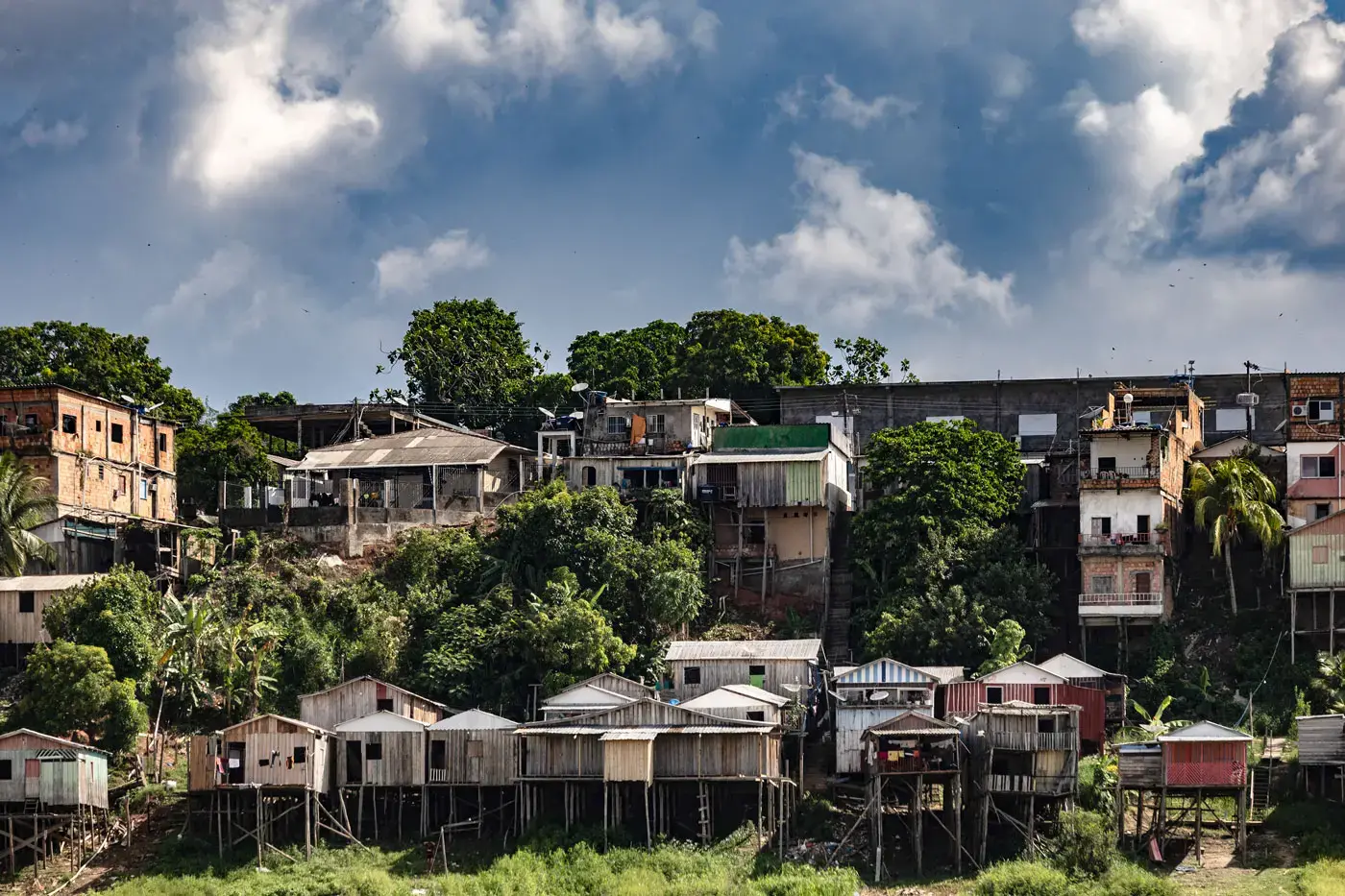
Making matters worse, the drought coincided with a series of weekslong heat waves. In September and October, withering conditions persisted across the Amazon, and temperatures here peaked at 39°C, 6°C above normal. Desiccated jungle set ablaze by farmers enveloped the city in choking smoke. Then, in the season’s most freakish episode, a sandstorm blotted out the Sun.
Drought and heat are only half of the story of the changes unfolding in the heart of the world’s largest rainforest. Schöngart and collaborators’ research on the river here has shown that for decades, while dry-season low water has been plummeting, rainy-season high water has been rising. The city has experienced frequent major flooding in recent years because of heavy rains across much of the Amazon Basin, forcing the officials to erect temporary wooden walkways above streets of the historic waterfront.
Schöngart and other researchers expect such changes to intensify as the global climate warms. The current drought provided a grim preview, killing river dolphins and fish, and threatening livelihoods for communities along the river. If the combination of higher highs and lower lows becomes the new norm, the ramifications could extend throughout the Amazon Basin and even beyond, threatening the very existence of the forest—which harbors much of the planet’s biodiversity, has a far-reaching influence over regional and global climate, and sustains millions of people.
“We are undergoing massive changes in the hydrological cycle” of the Amazon Basin, Schöngart says. The question now, he says, is whether its ecosystems and people can adapt.
ABOVE THE GROWL of an outboard engine, Ayan Fleischmann hollers orders to the boatman of a skiff plying the waters of Lake Tefé in October 2023. Fleischmann, a hydrologist at the Mamirauá Institute for Sustainable Development in Tefé, a lakeside city of 70,000, is monitoring the extreme conditions in the central Amazon, 600 kilometers upstream from Manaus, in one of the regions hit hardest by the drought. We coast to what looks like a remnant of a fence—a bleached wooden post jutting obliquely above the surface. Few would suspect it marks a temperature monitoring station. That’s intentional, Fleischmann says. “We put it on this kind of pole so that no one thinks it’s important,” he says, grinning.
He snags the unprepossessing post and fishes up a wristwatch-size data logger tied to a length of twine. The average water temperature for this time of year is 30°C, but the sensor recently recorded a high of 39.1°C. Fleischmann says shallower parts of the lake may have reached 41°C on that same day in late September. The air that month was hot, too, about 1.5°C above average. Meanwhile, the drought has shrunk the lake; by late October, Lake Tefé’s surface had sunk 6.5 meters below the average annual low. Together the low water and high air temperature took a deadly toll on wildlife.
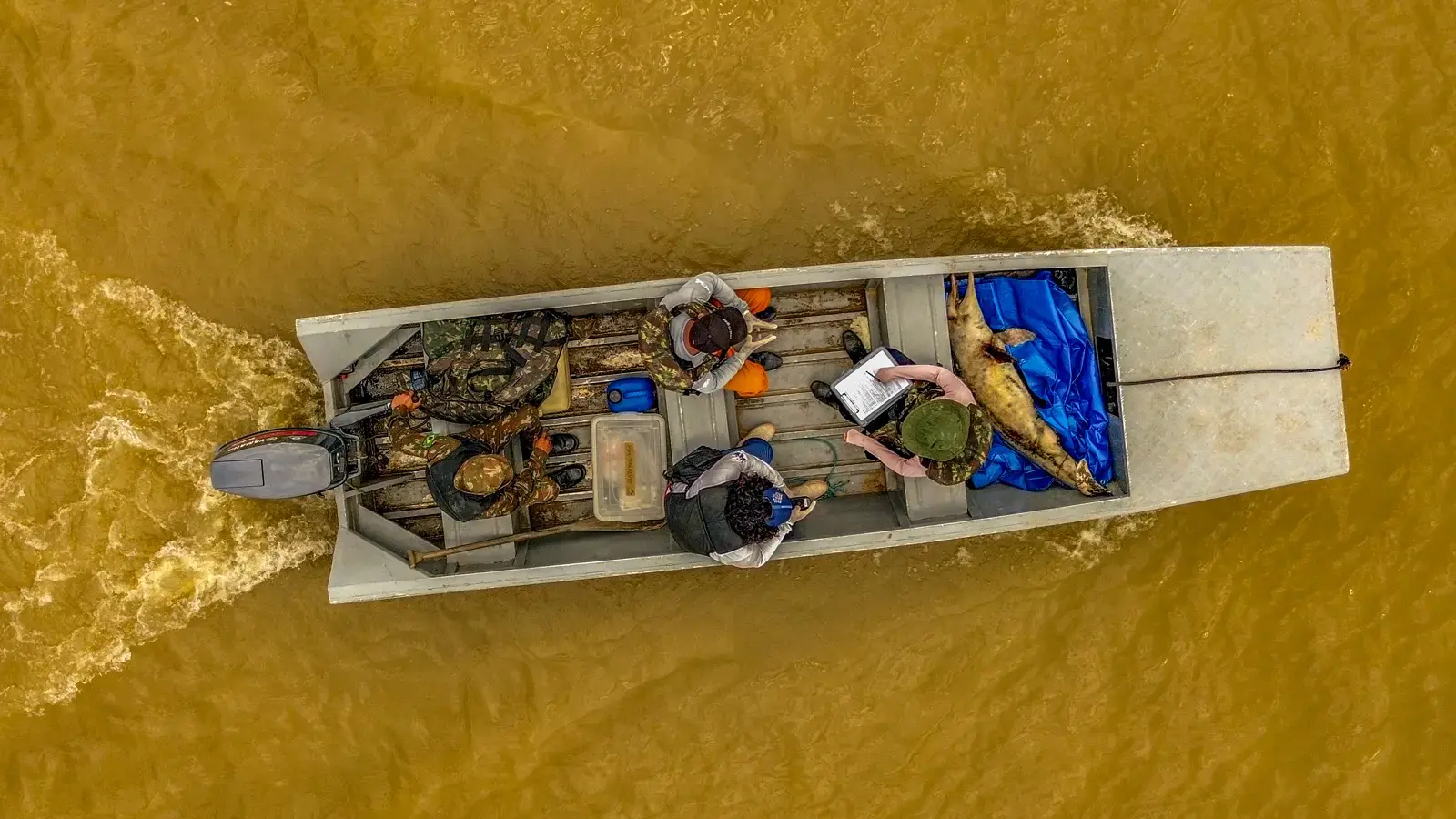
Within sight of Fleischmann’s temperature logger, four crouching figures cruise along Lake Tefé’s shore in a flat-bottomed jon boat, their faces wrapped in surgical masks. They beach the boat on a mudflat and lug ashore a bundle wrapped in a tarp. As they unfurl it in an open-sided tent that serves as a makeshift surgical suite, a dead dolphin thuds onto a metal dissection table. The stench of rotted flesh wafts up from the peeling and discolored corpse.
Half a dozen people lounging in the shade leap to their feet and pull on Tyvek suits, rubber gloves, and masks. One of them, Mariana Lobato, a researcher at Mamirauá, says the torpedo-shaped mammal is a female tucuxi (Sotalia fluviatilis), the smaller of two freshwater dolphin species that live here. It has probably been decaying for a day or two, she says. Lobato grabs a scalpel and cuts into its abdomen. “We’re measuring the fat,” she says, pointing to a creamcolored layer as thick as her thumb. The ample fat indicates that this tucuxi did not die of starvation. She and her colleagues slice deeper, cutting out bits of lung, brain, and other organs for later study.
The bodies began appearing in late September, recalls oceanographer Miriam Marmontel, who leads Mamirauá’s marine mammal group. Responding to reports from boaters, Mamirauá staff hauled 19 carcasses from the lake. In the days that followed, Marmontel says, her workers discovered dolphins “in agony, circling around themselves and not being able to dive.” They soon died. On 28 September, the day Fleischmann’s sensor logged the record high heat, 70 more corpses were discovered. All told they collected more than 200 dead dolphins, including both resident species—about 15% of the lake’s population—in the span of a few weeks. “It was something we could never expect. It really hit hard,” Marmontel says.
The record water temperatures were an obvious suspect for the calamity, but Marmontel’s team conducted more than 100 necropsies to eliminate other explanations. They found no evidence of infectious disease or a toxin. “We think that climate change is the major culprit,” she says. That worries her, she says, because it’s the only possibility with no local solution.
On the same hot September day, shimmering patches of dead fish coated large swaths of Lake Tefé’s surface—likely another casualty of the heat. A research team at INPA has shown that Amazonian fish can’t withstand temperatures higher than 35°C to 37°C. “Anything above that is a no-go,” says Alexandre Pucci Hercos, leader of the fish biology group at Mamirauá. “An extra degree may not seem like much, but it’s a big difference.” Today, Lake Tefé has hundreds of species of fish. But if, as anticipated, the harmful conditions become more frequent, Hercos says, “some species will migrate while others will become extinct.”
MANAUS AND TEFÉ are not anomalies. Most of the Amazon Basin’s main rivers fell dramatically and, in places, dried up completely in September and October, says Jose Marengo, a climate scientist at Brazil’s National Center for Monitoring and Early Warning of Natural Disasters. Heat blanketed 60% of the rainforest, with temperatures 2°C to 5°C above normal highs.
The immediate causes, climate scientists say, lie thousands of kilometers away, in pools of anomalously warm water in the Pacific and Atlantic oceans.
One well-established influence on temperature and precipitation in the Amazon is the El Niño-Southern Oscillation, a cyclical fluctuation in surface temperatures in the central and eastern equatorial Pacific Ocean. In its warm phase, El Niño, these regions are hotter than normal, creating low pressure zones in the overlying atmosphere that steer the moist air responsible for rain off its normal pathways—and, often, away from the Amazon. The El Niño that began in 2023 appeared unusually early in the year and is predicted to be one of the strongest on record by the time it ends.
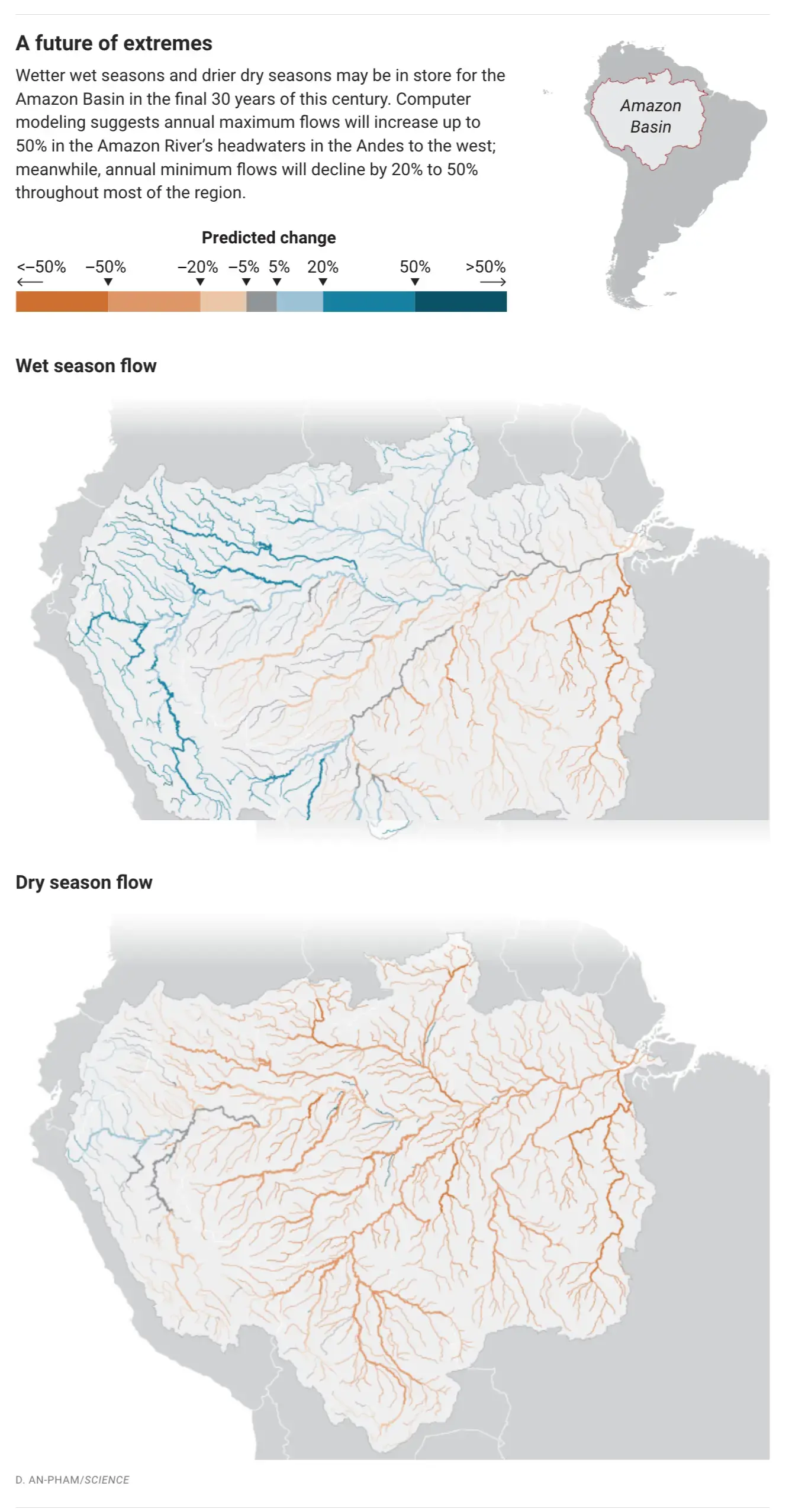
Another player in last year’s drought was unusual warmth in the Atlantic just north of the equator, which, like El Niño, drives moist air off course and has been linked to previous Amazon droughts. The Amazon Assessment Report 2021, an encyclopedic appraisal of the people, ecology, and climate of the Amazon, notes that of 15 megadroughts recorded between 1906 and 2021, six coincided with El Niño and three with warm tropical North Atlantic waters. Adding the 2023 drought, all four of this century’s droughts occurred when both ocean regions had warmed.
Climate change is an obvious suspect in the observed changes in the drought-fostering ocean conditions, although the mechanisms underlying its role are not clear. Some research suggests global warming might be increasing the strength and frequency of El Niños. And the broader increase in ocean temperatures caused by global warming could also be contributing, providing a backdrop for anomalous areas of hotter water in the Atlantic and Pacific. Global sea surface temperatures have been rising steadily for more than a century, but in 2023 the global average broke previous records every month beginning in April, a trend that has continued into this year.
A modeling experiment released last month by World Weather Attribution, an international collaboration of climate scientists, found that climate change has multiplied the likelihood of precipitation as low as that seen in the Amazon Basin in 2023 by a factor of 10. Its impact was even larger on the likelihood of an agricultural drought, in which low rainfall and high temperatures combine to parch the soil, stressing crops and wild vegetation alike. The modeling concluded that climate change has increased the likelihood of an agricultural drought as deep as that of 2023 by a factor of 30. Put more plainly, the drought would have been unlikely had climate change not warmed the planet. Marengo isn’t ready to say the drought was caused by climate change, but he sees it as a “sample” of what’s to come. “It seems like we are looking now at some of those things that could happen in the next decades.”
Climate change might also be a culprit in the extreme rainfall that has been occurring during wet seasons. Of the 18 “flood emergencies” declared in Manaus since 1902, half, including the four largest, have taken place since 2000. “Recent floods not only occur more often but also have become more severe,” Schöngart and colleagues wrote in a 2018 paper in Science Advances.
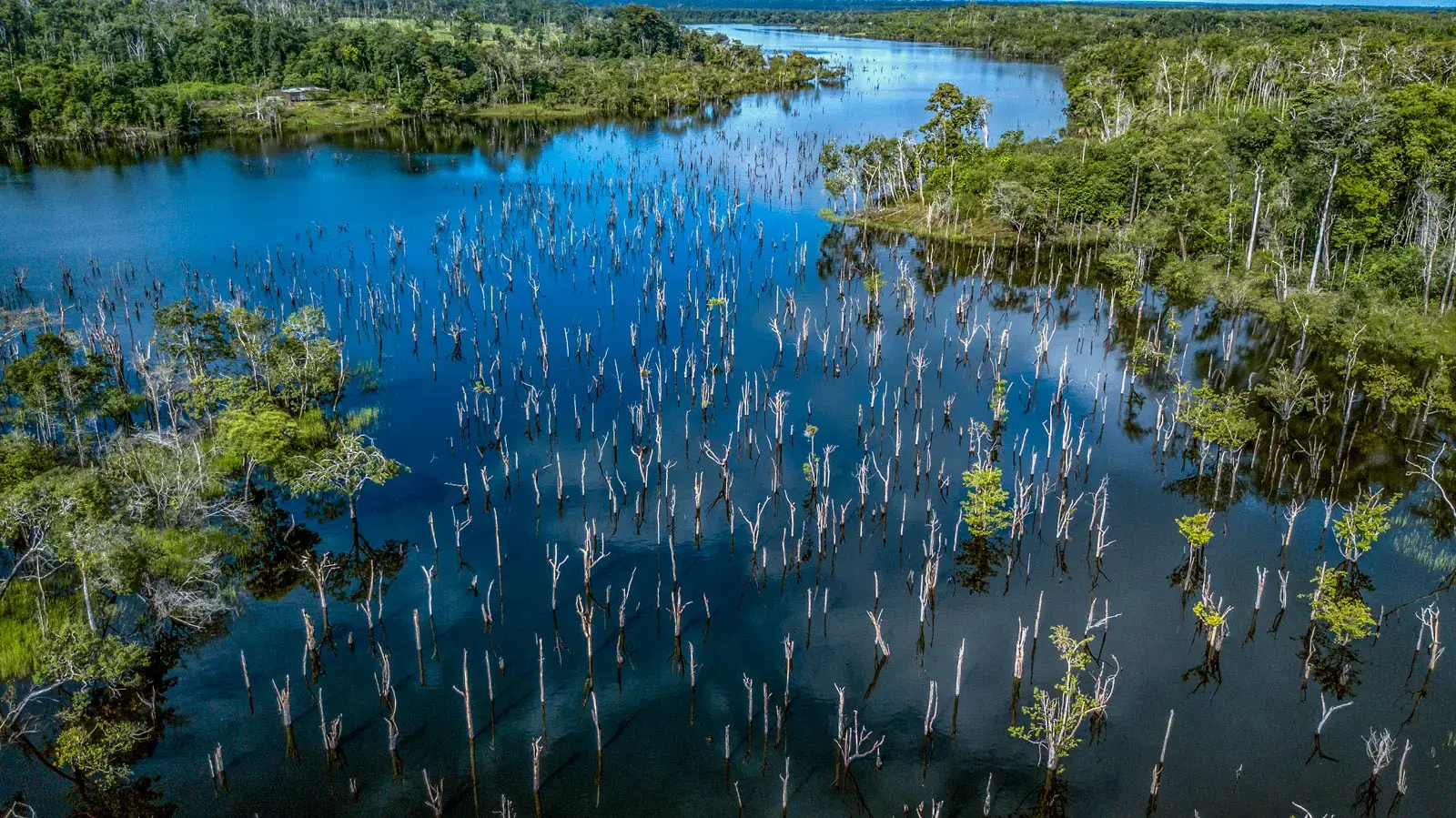
In the same paper, Schöngart and his colleagues propose a mechanism for the flooding. Beginning in the 1990s, they note, warming Atlantic surface water produced a pronounced temperature disparity between the Atlantic and the Pacific basins that has continued to grow. One driver, they suggest, is an anomalous warm ocean current linked to climate change that carries heat from the Indian Ocean around the Cape of Good Hope into the South Atlantic. The resulting temperature differential alters continental-scale wind patterns, perhaps funneling extra moisture from the ocean basins into the Amazon.
Whatever their precise cause, the floods are taking a toll. In June 2021, the river reached a historic high in Manaus, flooding tens of thousands of homes and prompting authorities to build 9 kilometers of boardwalks above the streets. Villagers near Lake Tefé say the stilts their houses sit on aren’t always high enough anymore to keep them dry when it floods. During unusual wet seasons, some families install temporary floors, 1 meter or more above the original, and enter through windows rather than the front door.
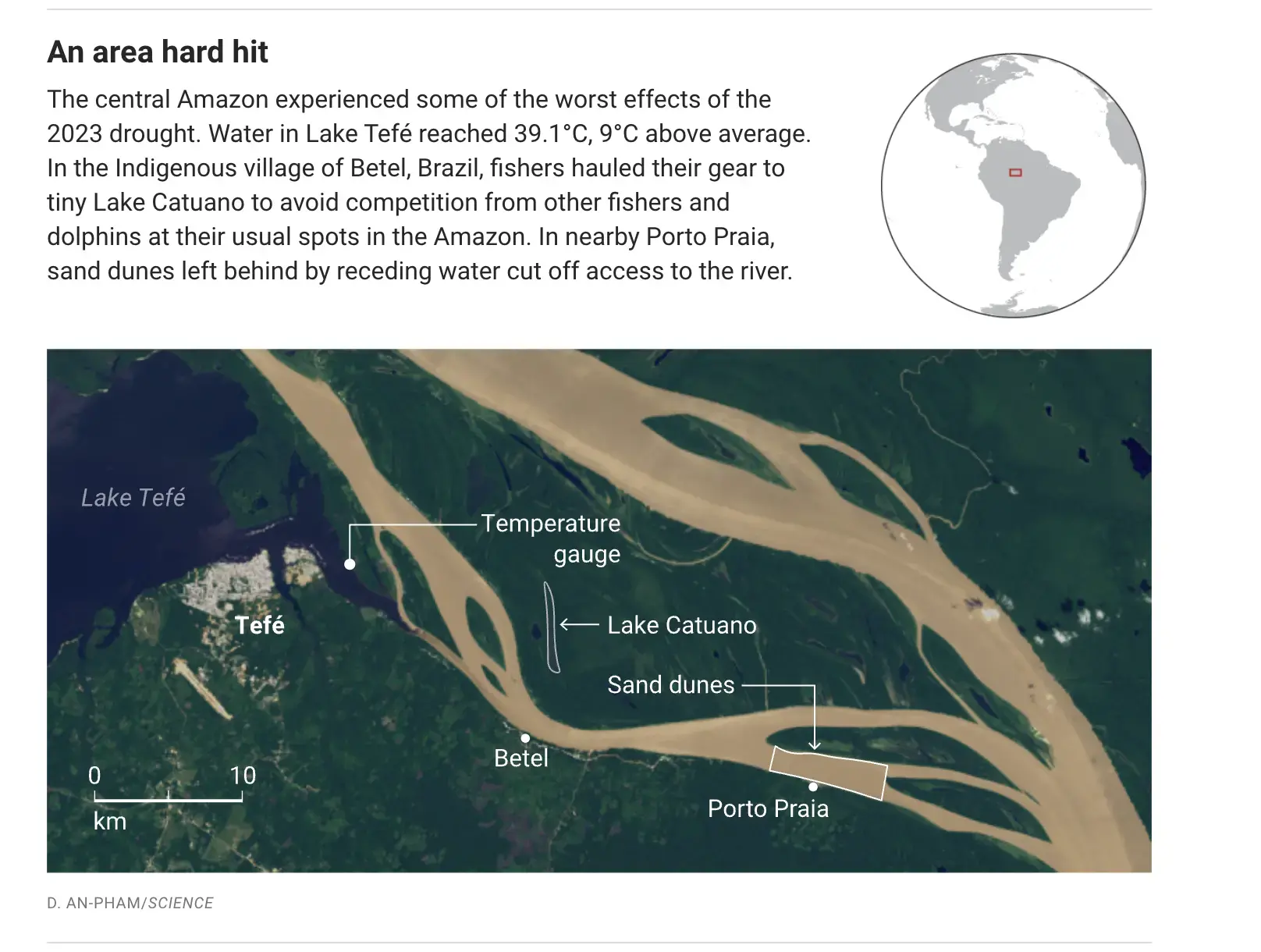
Forests, too, may be at risk. Some trees in the low-lying floodplains of the Amazon and its tributaries are adapted to up to 10 months of inundation, far more than normal trees can withstand. But even these trees have their limits. In a 2020 study, Schöngart and colleagues documented a pattern of tree mortality coinciding with years of high water in Jaú National Park in the central Amazon, concluding that more intense flooding in recent decades is already damaging these trees.
In the future, excessively high water could also threaten some wildlife, says Rafael Rabelo, research coordinator at Mamirauá. He’s particularly concerned about the black squirrel monkey (Saimiri vanzolinii), which only lives near Tefé in 800 square kilometers of the seasonally inundated jungle called igapó. A modeling study is exploring whether the higher flood waters expected in the future will damage the igapó, which could put the primates themselves at risk.
“IF THE DROUGHT continues, we are worried that we will run out of food,” says Márcio da Silva Santos, the tuxaua, or chief, of the Indigenous village of Betel. A concrete and packed-dirt staircase of 130 steps descends steeply from the village, on a bluff overlooking the Amazon River near Tefé, to the shrunken river. The steps are the first stage of a grueling trip made necessary by the drought. Santos grunts under the weight of a handmade wooden canoe he and three other Kambeba tribe members are taking turns carrying, two at a time, down the slope. When they reach the water, they position the canoe on the gunnels of a motorized skiff, ferry it across the Amazon, then hoist it back onto their shoulders and haul it through the jungle. Finally, they arrive at a long skinny body of water, Lake Catuano, a former meander left behind when the Amazon changed course long ago. They cast nets and drop lines, hoping to capture basket loads of pacu, piranha, curimatã, and other choice fish.
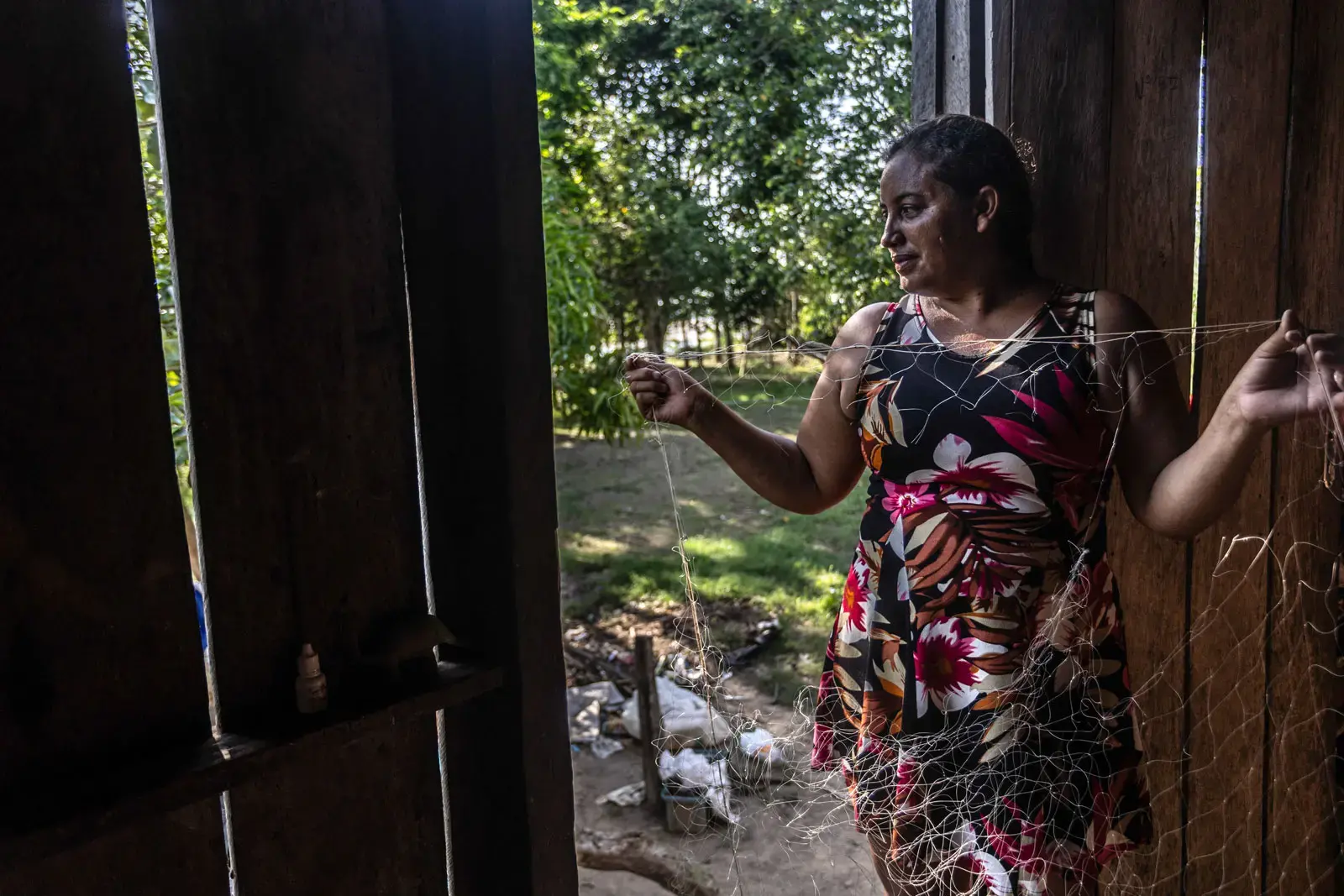
Santos says he would rather fish a short boat ride from his village, in the Amazon proper. But since the drought took hold, there’s too much competition from commercial fishers who’ve abandoned Lake Tefé’s literally overheated fishery—and from river dolphins that stake out the pools where fish gather in the depleted river. The dolphins relentlessly rip nets and steal the catch unless they’re constantly shooed away—or beaten back with a jabunque, a cudgel fishers carry for this purpose.
It’s not only fishing that has become harder. Planting and harvesting of cassava, a staple starch and the most important cash crop for many of the region’s Indigenous people, has also been disrupted. In Betel, the heat this season is so intense that farmers can’t work their fields after 9 a.m. Santos says small streams that provide water used for processing cassava root and turning it into flour have dried up, forcing villagers to wait for the end of the drought to process the food.
What concerns Santos most, though, is an unprecedented wildfire that occurred one evening in September. As is customary, villagers had prepared a cassava field by cutting down stalks remaining after the previous harvest and leaving them to dry before setting them on fire. This traditional slash-and-burn method disposes of discarded vegetation, kills weeds, and produces nutrient-rich ash.
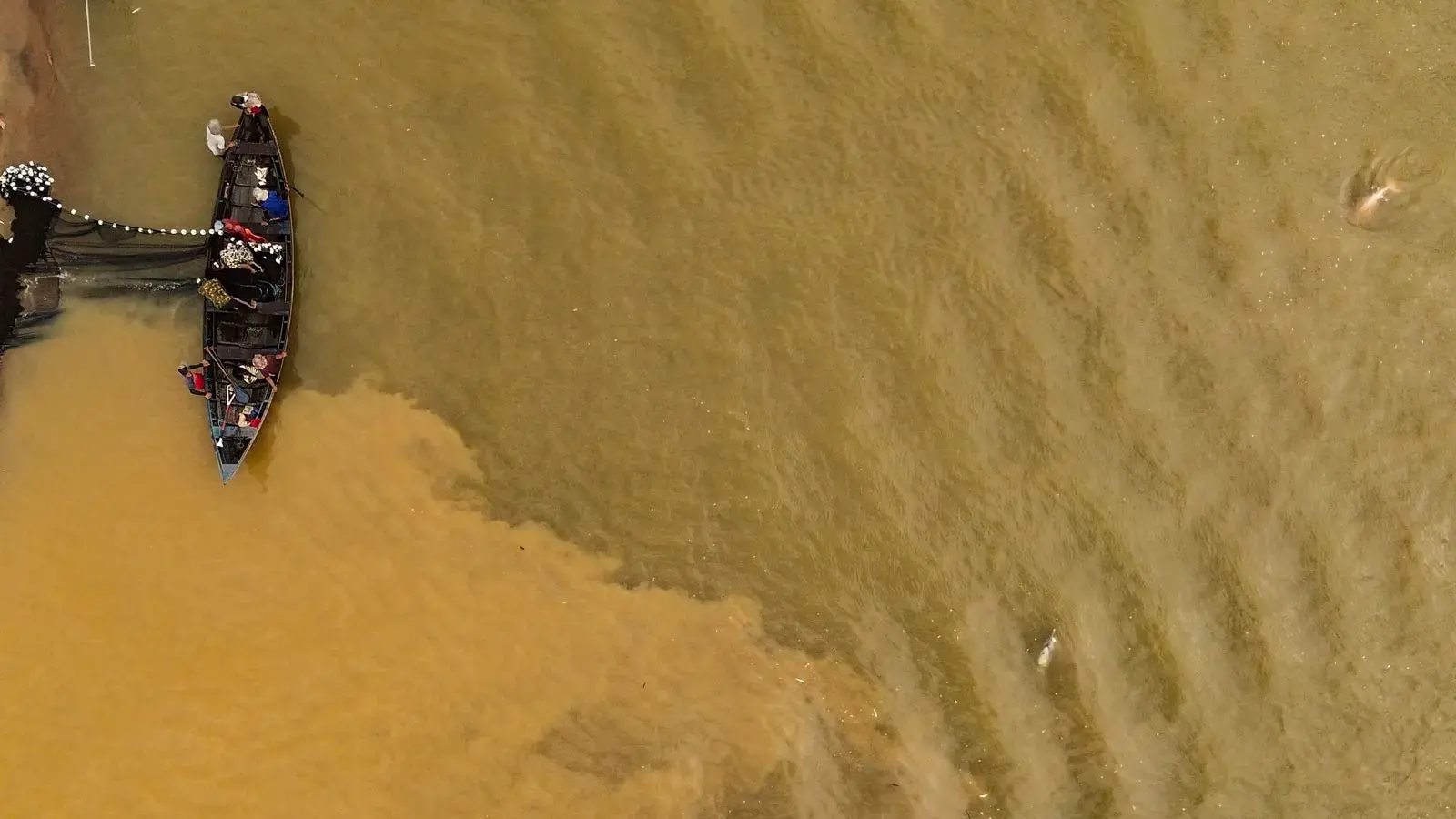
Normally, such fires peter out where the prepared field ends and the surrounding primary forest begins. But this time the flames kept going. First, they spread into a neighboring field, destroying a patch of açaí palm saplings that would have eventually produced berries for local consumption and sale to outsiders. Then, for the first time since the town was founded 53 years ago, the fire escaped into wild forest. “We had never seen fire like this,” Santos says. “We cannot explain it.”
Villagers tried unsuccessfully to extinguish the blaze with buckets of water and makeshift brooms. Luckily, a rain shower came that night and extinguished it. The farmers were spooked and too fearful of another fire to burn more fields. In community meetings, the village and three neighboring communities decided that next year they’ll try to prepare some fields without fire. The plan will require a tractor they hope to borrow from a regional development agency.
A few minutes down the Amazon by boat from Betel, another Indigenous community, Porto Praia, has seen a different mix of troubles. An island off the town’s waterfront creates a kilometer-wide channel that separates the village from the Amazon’s main stem. In September, the channel completely dried up, revealing an expanse of sand dunes as tall as a person. Fleischmann calls such dune fields “Sahara on the Amazon.”
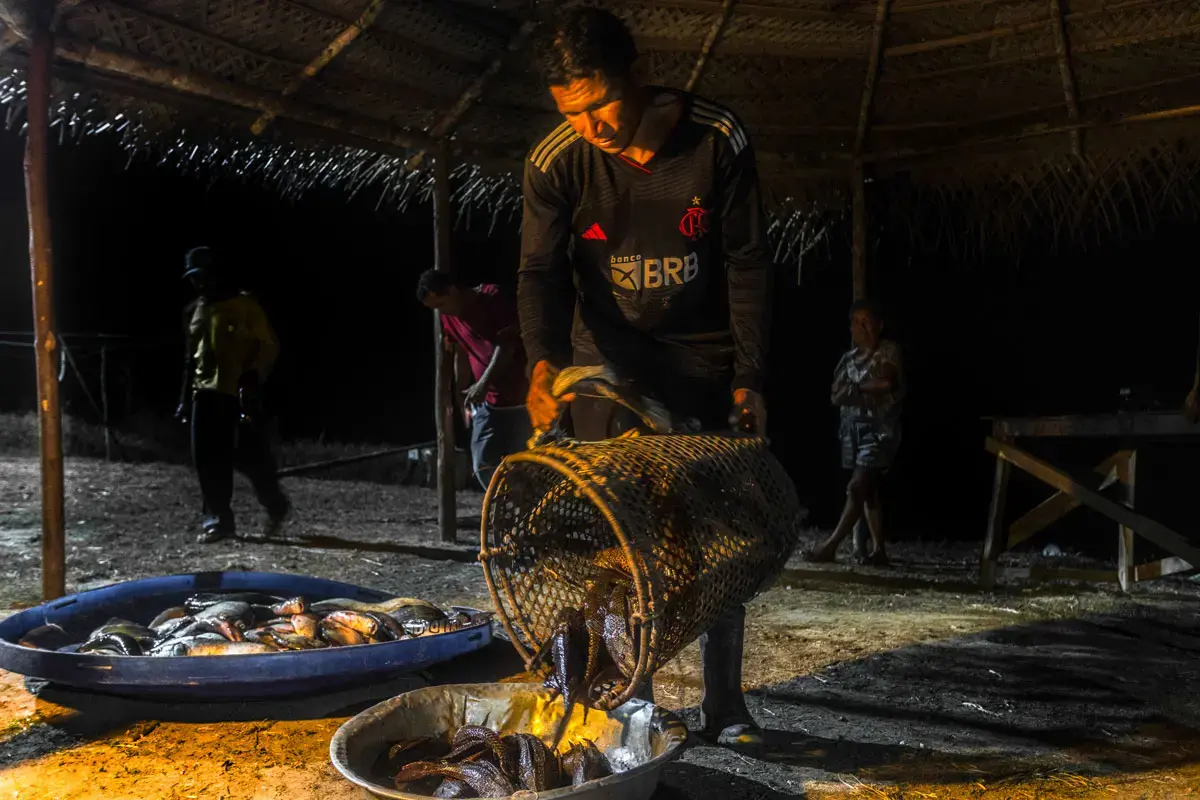
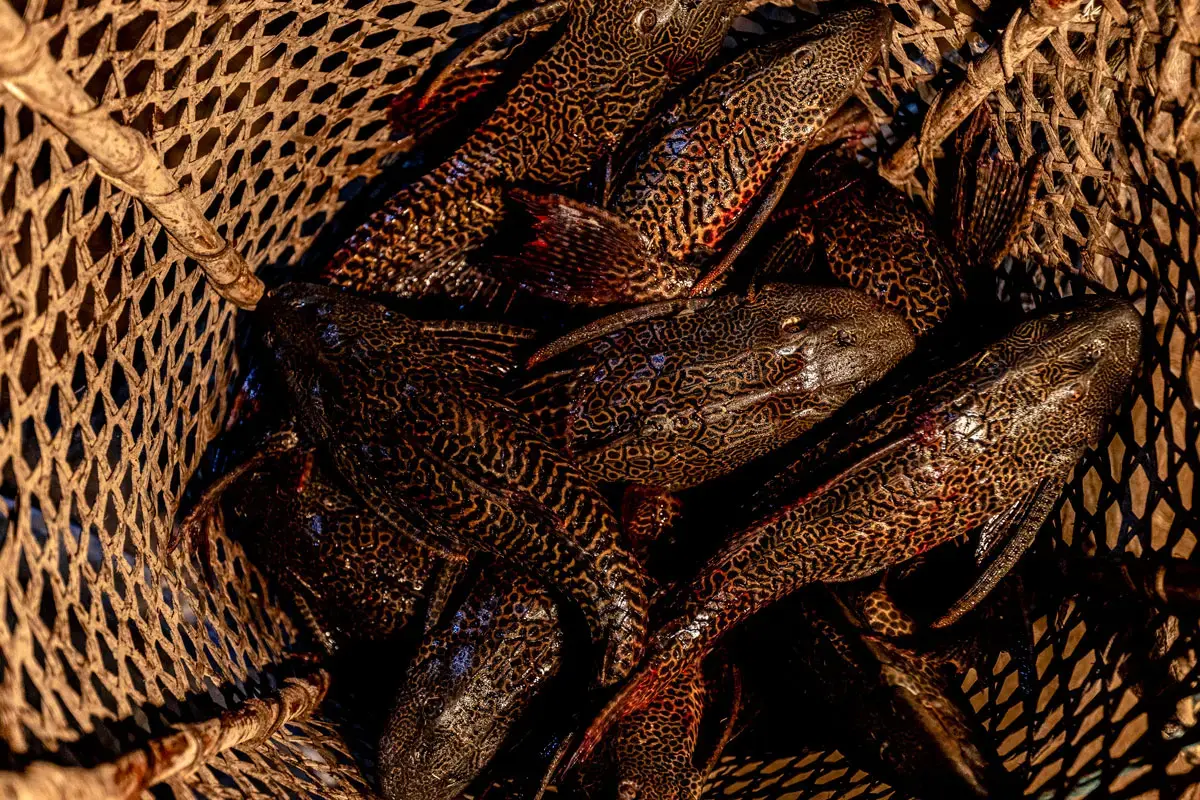
Drier dry seasons and wetter wet seasons are conspiring to produce the dunes, he says. Fueled by extreme wet-season rainfall in headwaters, floods are scouring riverbeds more powerfully, eroding upstream shorelines and carrying heavier loads of sediment that get deposited where the current slows, such as off Porto Praia. Then they are exposed by drought. The town’s dunes first appeared during the 2022 dry season; with the 2023 drought they made the waterfront landlocked for the first time.
Until the rains return and the river rises again, Porto Praia villagers—who have no road access to Tefé, the nearest commercial area—have to walk 1 hour to get to a boat, doubling their travel time. Porto Praia’s one school has closed because most of its teachers commute from Tefé. The villagers have also taken to fishing at night because carrying gear and baskets of fish across the dunes to their preferred lake during the heat of the day is unbearable. “It’s hard to fish during daytime nowadays because of the heat,” says Anilton Bras da Silva, chief of Porto Praia. “In past droughts, we could manage.”
BRUCE FORSBERG, an ecologist who has studied the Amazon for more than 4 decades, says Porto Praia and Betel will probably see worse. Forsberg directs the Large-Scale Biosphere-Atmosphere Experiment, a long-running international collaboration focused on links between the Amazonian rainforest and global climate. He and a team of Brazilian and U.S. scientists have modeled how warming from a continued increase in fossil fuel emissions would affect river flows.
On a large monitor at his office in Manaus, he pulls up maps of the region, its rivers color coded to indicate projected changes in water flow in the final 3 decades of this century. A wet-season map shows most of the Amazon’s tributaries as sinuous dark blue and teal lines, indicating the model’s prediction that almost all of the Amazon’s headwaters in the Andes will discharge 20% to 50% more water by the end of the century. Wet-season discharge in the main stem of the Amazon itself will increase up to 20% over most of its length, suggesting serious flooding in Manaus and much of the rest of the region.
In contrast, reddish hues color the rivers on a map showing dry season flows. According to the model, low-water discharge of every major river in the basin will plummet by more than 20% over most of their lengths. The low-water level of most of the Xingu, a river in the east that today carries half as much water as the Mississippi, will decline by more than 50%. That could upend the financial rationale for the recently completed Belo Monte power complex, one of the world’s largest hydroelectric stations, Forsberg says. The team published these modeling results in Climatic Change in 2016, and Forsberg says events like last year’s drought suggest the basic pattern they predicted is now starting to occur.
A paper published last year in the Journal of Hydrology paints a similar picture. Looking ahead 40 years, modeling based on four distinct climate models forecast many headwater regions will experience floodwater increases of more than 50%, while low water will hit downstream regions hardest, with flow decreases of more than 33%. Those dire changes unfolded in the models even with a substantial global reduction in fossil fuel use.
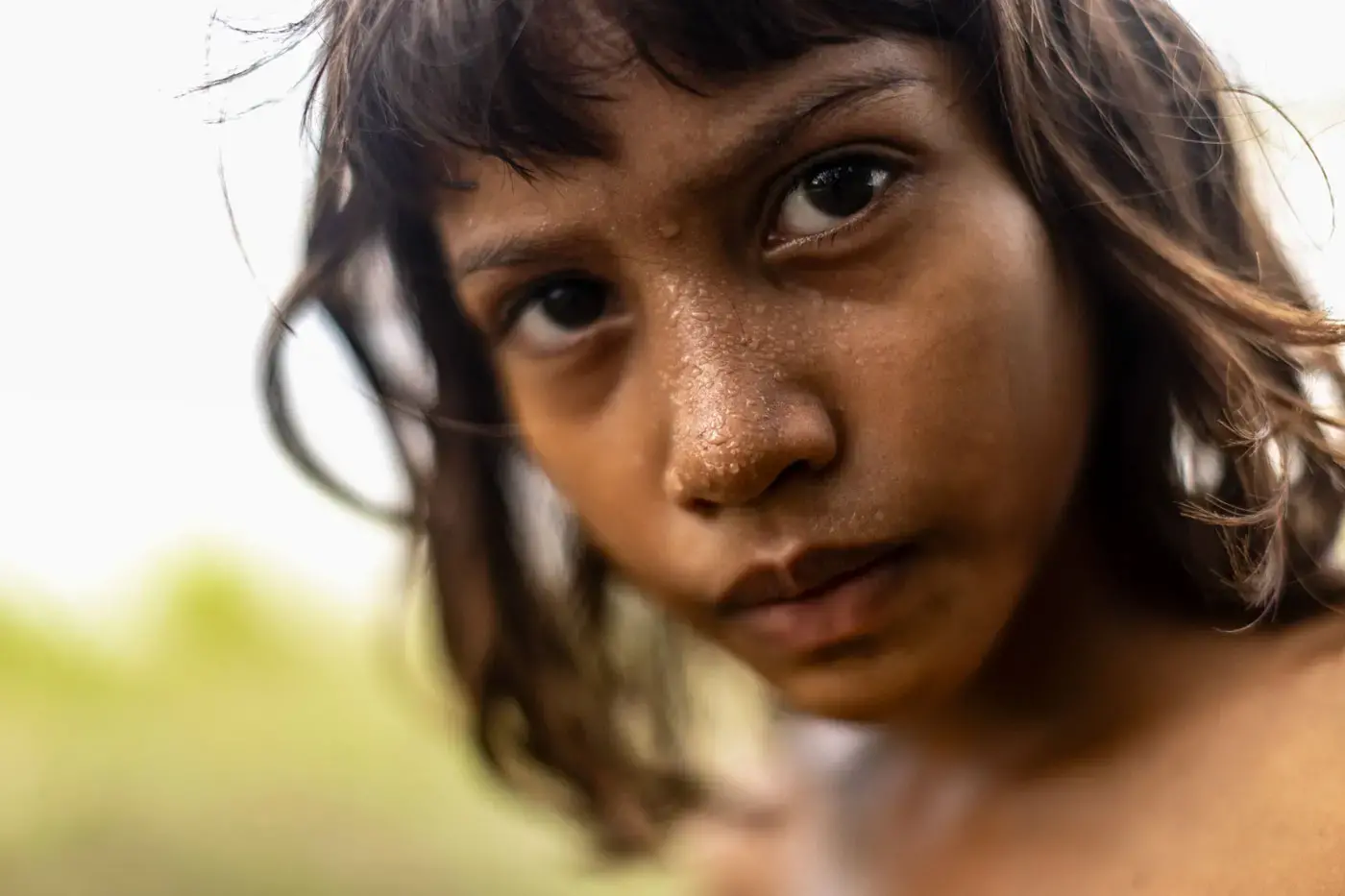
Forsberg says similar extremes are likely to afflict southern Brazil and other parts of South America, because conditions in the Amazon Basin influence rainfall patterns for thousands of kilometers around. A 2019 paper in the Journal of Climate estimated that “aerial rivers” of moisture from the Amazon contribute 16% of the rainfall in the La Plata River Basin, one of the world’s largest catchments, extending from the southern edge of the Amazon Basin for more than 2000 kilometers to Buenos Aires, Argentina. Those aerial flows are now in peril, Forsberg says, which could shrink rivers, parch crops, and hamper power plants on which millions of people depend. “It’s going to have disastrous effects … that are going to leak down to all of South America.”
BEFORE I LEFT BRAZIL, Santos, the tuxaua of Betel, invited me for a meal. He built a fire and skewered a jaraqui, a fish the size of a dinner plate and thin as my palm, with a slender green branch. While it roasted over the coals my interpreter, Diana Mayra Köhler, said, “Comeu jaraqui, nao sai mais daqui”—“If you’ve tasted jaraqui, you’ll never leave here”—an Amazonian maxim that rhymes charmingly in Portuguese.
Once, Santos could count on the Amazon to yield plenty of jaraqui and other delicacies. Now, he fears that the changes sweeping the region will spark disastrous competition for the bounty. He’s willing to avoid fishing in the river to help the dolphins survive. “We don’t disturb them so that they don’t have to suffer anymore.” But he’s worried that more harvesting in skinny Lake Catuano could put Betel at odds with other villages that also sometimes rely on it. “This is a delicate situation for us.”
The same could be said for the great river sliding past the village, and the forest all around.






